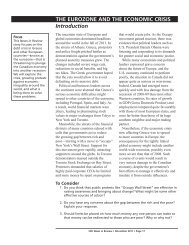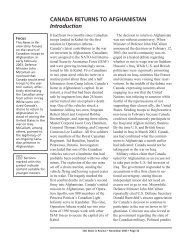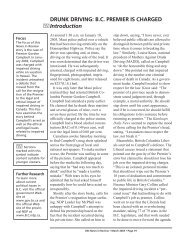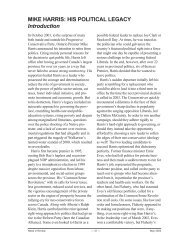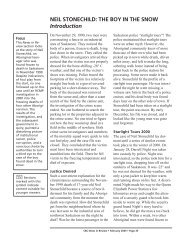Extreme Sports: Tempting Fate - News in review
Extreme Sports: Tempting Fate - News in review
Extreme Sports: Tempting Fate - News in review
Create successful ePaper yourself
Turn your PDF publications into a flip-book with our unique Google optimized e-Paper software.
Contents<br />
<strong>Extreme</strong> <strong>Sports</strong>: <strong>Tempt<strong>in</strong>g</strong> <strong>Fate</strong>?<br />
Like most <strong>News</strong> <strong>in</strong> Review stories, this analysis of the<br />
phenomenon of proliferat<strong>in</strong>g and <strong>in</strong>creas<strong>in</strong>gly dangerous sports<br />
is much more than what first meets the eye. This is a story about<br />
human behaviour, human needs, and contemporary social<br />
values. The story asks many fundamental questions: What is the<br />
nature of sport? When is the l<strong>in</strong>e crossed <strong>in</strong> terms of risk <strong>in</strong> a<br />
sport? Why do people engage <strong>in</strong> any recreational activity that<br />
puts their lives at risk, be it mounta<strong>in</strong> climb<strong>in</strong>g, drug use, heliski<strong>in</strong>g,<br />
day trad<strong>in</strong>g, or reckless driv<strong>in</strong>g? Do extreme sports fulfill<br />
extreme needs? What social conditions or psychological needs<br />
generate these activities?<br />
Introduction<br />
A Relative Term<br />
The Nature Of <strong>Sports</strong><br />
A New Game In Town<br />
When Different and Dar<strong>in</strong>g Become Dangerous<br />
Hard-Wired Or Learned Behaviour?<br />
<strong>Extreme</strong> Spectators<br />
Risk Market<strong>in</strong>g<br />
The Role Of The Media<br />
Discussion, Research, and Essay Questions<br />
.
Comprehensive <strong>News</strong> <strong>in</strong> Review Study Modules<br />
Us<strong>in</strong>g both the pr<strong>in</strong>t and non-pr<strong>in</strong>t material from various issues of <strong>News</strong> <strong>in</strong> Review, teachers and<br />
students can create comprehensive, thematic modules that are excellent for research purposes,<br />
<strong>in</strong>dependent assignments, and small group study. We recommend the stories <strong>in</strong>dicated below for the<br />
universal issues they represent and for the archival and historic material they conta<strong>in</strong>.<br />
Même: The Cost of Self-image, March 1992<br />
Gambl<strong>in</strong>g <strong>in</strong> Canada: Risky Bus<strong>in</strong>ess, March 1993<br />
TV Violence: Who Gets Hurt? May 1993<br />
New Drivers: Graduated Licences, December 1993<br />
Figure Skat<strong>in</strong>g: W<strong>in</strong>n<strong>in</strong>g At Any Price, March 1994<br />
Teen Road Deaths: A Survivor Pays Penance, May 1996<br />
Smok<strong>in</strong>g: The Campaign Aga<strong>in</strong>st Addiction, October 1996<br />
Victims of Fashion, February 1997<br />
Marijuana: Tak<strong>in</strong>g Another Look, April 1998<br />
Other Related Videos Available from CBC Non-Broadcast Sales<br />
Does Your Resource Collection Include These CBC Videos?<br />
<strong>Extreme</strong> Expenses<br />
Nancy Greene
Introduction<br />
<strong>Extreme</strong> <strong>Sports</strong>: <strong>Tempt<strong>in</strong>g</strong> <strong>Fate</strong>?<br />
Why do we enjoy tak<strong>in</strong>g risks? In our society, there is a degree<br />
of danger and fear <strong>in</strong> many leisure activities, and as one<br />
snowboarder says, If there s no fear factor, I dunno, I don t th<strong>in</strong>k<br />
it s any fun. People water-ski, watch scary movies, or ride roller<br />
coasters know<strong>in</strong>g full well that their heart will race and they may<br />
get a knot <strong>in</strong> their stomach. Far from be<strong>in</strong>g an unpleasant<br />
feel<strong>in</strong>g, people equate these thrills with enterta<strong>in</strong>ment and<br />
enjoyment and they keep com<strong>in</strong>g back for more. However, there<br />
is fear, and then there is extreme fear. When watch<strong>in</strong>g a movie<br />
or ski<strong>in</strong>g down a groomed ski hill, the actual physical danger is<br />
m<strong>in</strong>imal if one is adept, well-tra<strong>in</strong>ed, rational, and responsible.<br />
We know that we will survive the risk and cont<strong>in</strong>ue our rout<strong>in</strong>e<br />
lives. <strong>Extreme</strong> sports, on the other hand, <strong>in</strong>volve a real physical<br />
danger or death. That is the essence of these activities, which<br />
have steadily <strong>in</strong>creased <strong>in</strong> popularity <strong>in</strong> the 1990s.<br />
<strong>Extreme</strong> sports are derived from both traditional and nontraditional<br />
sport<strong>in</strong>g activities. Traditional sports such as bicycl<strong>in</strong>g<br />
or ski<strong>in</strong>g can be made extreme by modify<strong>in</strong>g the equipment and<br />
locales. <strong>Extreme</strong> athletes, usually teenagers, will ride a BMX<br />
bike up and down steep ramps perform<strong>in</strong>g turns and flips that<br />
are evaluated by judges or, more importantly, their peers.<br />
<strong>Extreme</strong> skiers will trek <strong>in</strong>to backwoods, often avalanche-prone,<br />
areas to seek out the perfect powder or the best natural jumps.<br />
Skateboard<strong>in</strong>g, bungee jump<strong>in</strong>g, downhill mounta<strong>in</strong> bike races,<br />
rock or ice climb<strong>in</strong>g, and whitewater kayak<strong>in</strong>g are among the<br />
many extreme sports practised today. Part of the mystique of
extreme sports is that they are new or radical. The limits of<br />
current extreme sports are constantly expand<strong>in</strong>g and chang<strong>in</strong>g,<br />
and new sports are <strong>in</strong>vented regularly to feed the thrill factor.<br />
<strong>Extreme</strong> athletes value highly the reputation of trailbreaker or<br />
outlaw that goes with be<strong>in</strong>g on the edge of what is acceptable.<br />
Watch<strong>in</strong>g ultimate activities can also be compell<strong>in</strong>g, if not<br />
excit<strong>in</strong>g. Rat<strong>in</strong>gs for extreme sports programm<strong>in</strong>g are high, and<br />
television networks and specialty channels have rushed to<br />
<strong>in</strong>corporate them <strong>in</strong>to their schedules. Audience rat<strong>in</strong>gs <strong>in</strong>dicate<br />
that significant numbers of viewers enjoy watch<strong>in</strong>g athletes flirt<br />
with death. There is also evidence of a morbid public fasc<strong>in</strong>ation;<br />
<strong>in</strong>fota<strong>in</strong>ment reality programm<strong>in</strong>g show<strong>in</strong>g videotaped accidents<br />
and even deaths are popular with viewers. Even news<br />
programm<strong>in</strong>g is susceptible. When show<strong>in</strong>g images of accidents,<br />
<strong>in</strong> sport<strong>in</strong>g events or otherwise, there can be a f<strong>in</strong>e l<strong>in</strong>e between<br />
what is legitimate public <strong>in</strong>formation and what is gratuitous<br />
titillation.<br />
What makes people seek out these activities, and why are some<br />
people more likely to go to extremes than others? Are some risktakers<br />
genetically predisposed to seek thrills while others learn<br />
or are socially conditioned through repeated exposure to actually<br />
like the feel<strong>in</strong>gs extreme risk-tak<strong>in</strong>g creates? There is also some<br />
debate as to whether humans have residual <strong>in</strong>st<strong>in</strong>ctive behaviour<br />
that makes high-risk adventure an evolutionary advantage. In<br />
sociological terms, to what extent have we actually made<br />
extreme sports culturally acceptable; are they really a<br />
manifestation of a society that is experienc<strong>in</strong>g and act<strong>in</strong>g out<br />
high-risk economic and social conditions? <strong>Extreme</strong> sports may<br />
also only be a fad. People may tire of their excesses. However,<br />
the full impact of extreme sports and their potential for harm, or<br />
for good, have yet to be objectively determ<strong>in</strong>ed.<br />
Introduction<br />
A Relative Term<br />
The Nature Of <strong>Sports</strong><br />
A New Game In Town<br />
When Different and Dar<strong>in</strong>g Become Dangerous<br />
Hard-Wired Or Learned Behaviour?<br />
<strong>Extreme</strong> Spectators<br />
Risk Market<strong>in</strong>g<br />
The Role Of The Media<br />
Discussion, Research, and Essay Questions<br />
.
Comprehensive <strong>News</strong> <strong>in</strong> Review Study Modules<br />
Us<strong>in</strong>g both the pr<strong>in</strong>t and non-pr<strong>in</strong>t material from various issues of <strong>News</strong> <strong>in</strong> Review, teachers and<br />
students can create comprehensive, thematic modules that are excellent for research purposes,<br />
<strong>in</strong>dependent assignments, and small group study. We recommend the stories <strong>in</strong>dicated below for the<br />
universal issues they represent and for the archival and historic material they conta<strong>in</strong>.<br />
Même: The Cost of Self-image, March 1992<br />
Gambl<strong>in</strong>g <strong>in</strong> Canada: Risky Bus<strong>in</strong>ess, March 1993<br />
TV Violence: Who Gets Hurt? May 1993<br />
New Drivers: Graduated Licences, December 1993<br />
Figure Skat<strong>in</strong>g: W<strong>in</strong>n<strong>in</strong>g At Any Price, March 1994<br />
Teen Road Deaths: A Survivor Pays Penance, May 1996<br />
Smok<strong>in</strong>g: The Campaign Aga<strong>in</strong>st Addiction, October 1996<br />
Victims of Fashion, February 1997<br />
Marijuana: Tak<strong>in</strong>g Another Look, April 1998<br />
Other Related Videos Available from CBC Non-Broadcast Sales<br />
Does Your Resource Collection Include These CBC Videos?<br />
<strong>Extreme</strong> Expenses<br />
Nancy Greene
A Relative Term<br />
<strong>Extreme</strong> <strong>Sports</strong>: <strong>Tempt<strong>in</strong>g</strong> <strong>Fate</strong>?<br />
What s <strong>in</strong> a name? The 1920s were nicknamed the Roar<strong>in</strong>g<br />
Twenties. Other decades have their descriptors: the Dirty<br />
Thirties, the Fabulous Fifties, the Sw<strong>in</strong>g<strong>in</strong>g Sixties. Could a valid<br />
case be made for call<strong>in</strong>g the 1990s the <strong>Extreme</strong> N<strong>in</strong>eties?<br />
<strong>Extreme</strong> is a common word some would say over-used to<br />
describe numerous areas <strong>in</strong> our society. It is used to describe<br />
aspects of such varied activities as sports, music, fashion,<br />
bus<strong>in</strong>ess, and even vacations. Dictionary def<strong>in</strong>itions use words<br />
such as utmost, <strong>in</strong>tense, or lack<strong>in</strong>g restra<strong>in</strong>t to expla<strong>in</strong> extreme.<br />
However, words often fail to capture the essence of the feel<strong>in</strong>gs<br />
<strong>in</strong>volved when experienc<strong>in</strong>g or watch<strong>in</strong>g such activities.<br />
Categorization<br />
Prior to watch<strong>in</strong>g this <strong>News</strong> <strong>in</strong> Review report proceed as follows:<br />
1. Take a few moments on your own and write a short paragraph<br />
<strong>in</strong> which you summarize what extreme means to you. Try to<br />
balance your def<strong>in</strong>ition by us<strong>in</strong>g both positive and negative<br />
terms. For example, you may th<strong>in</strong>k that extreme experiences<br />
help def<strong>in</strong>e your <strong>in</strong>dividuality but at the same time you may also<br />
recognize that these activities might be foolhardy.<br />
2. After you have written your summary, make a short list of<br />
activities that you would describe as extreme.<br />
3. Now, work<strong>in</strong>g <strong>in</strong> small groups, discuss your def<strong>in</strong>itions and
examples with others. What similarities and differences are<br />
there? What reasons are there for participat<strong>in</strong>g <strong>in</strong> extreme<br />
activities? What reasons are there for not participat<strong>in</strong>g <strong>in</strong> them?<br />
Perception<br />
Now watch this <strong>News</strong> <strong>in</strong> Review program and while you do so,<br />
note carefully the different extreme sports shown. Note<br />
especially how they are depicted. For example, gravity<br />
competitions (skateboard<strong>in</strong>g, roller blades, bicycle jumps) are<br />
often accompanied by fast and/or pulsat<strong>in</strong>g music. Likewise, film<br />
productions of heli-skiers <strong>in</strong>corporate various camera shots or<br />
slow motion that highlights the symmetry of the turns carved <strong>in</strong>to<br />
fresh powder. These devices can alter the perception of the<br />
activity for both the viewer and the participant.<br />
<strong>Extreme</strong>ness touches all aspects of our society; all the<br />
connections are not immediately obvious. What is the effect of<br />
extreme sports on society? Use the follow<strong>in</strong>g to help you<br />
organize your thoughts.<br />
1. When do the activities cross the l<strong>in</strong>e and become extreme ?<br />
2. What attitudes or words are expressed by the participants to<br />
justify these sports?<br />
3. What feel<strong>in</strong>gs do you experience when view<strong>in</strong>g the images of<br />
these sports?<br />
4. What impact do extreme sports have on society?<br />
5. Do the <strong>in</strong>evitable and predictable accidents enhance or deter<br />
people from undertak<strong>in</strong>g extreme sports?<br />
Follow-up Discussion<br />
Those who regularly participate <strong>in</strong> extreme sports or are regular<br />
viewers of such events may have a different perception of life<br />
compared with those who play it safe. The <strong>in</strong>creased popularity<br />
of extreme sports may also suggest that a significant portion of<br />
the population wants or needs a regular dose of <strong>in</strong>tense<br />
activities. Discuss what effect this might have on the follow<strong>in</strong>g<br />
areas: school, social activities, media, personal lives.<br />
Introduction<br />
A Relative Term<br />
The Nature Of <strong>Sports</strong><br />
A New Game In Town<br />
When Different and Dar<strong>in</strong>g Become Dangerous
Hard-Wired Or Learned Behaviour?<br />
<strong>Extreme</strong> Spectators<br />
Risk Market<strong>in</strong>g<br />
The Role Of The Media<br />
Discussion, Research, and Essay Questions<br />
Comprehensive <strong>News</strong> <strong>in</strong> Review Study Modules<br />
Us<strong>in</strong>g both the pr<strong>in</strong>t and non-pr<strong>in</strong>t material from various issues of <strong>News</strong> <strong>in</strong> Review, teachers and<br />
students can create comprehensive, thematic modules that are excellent for research purposes,<br />
<strong>in</strong>dependent assignments, and small group study. We recommend the stories <strong>in</strong>dicated below for the<br />
universal issues they represent and for the archival and historic material they conta<strong>in</strong>.<br />
Même: The Cost of Self-image, March 1992<br />
Gambl<strong>in</strong>g <strong>in</strong> Canada: Risky Bus<strong>in</strong>ess, March 1993<br />
TV Violence: Who Gets Hurt? May 1993<br />
New Drivers: Graduated Licences, December 1993<br />
Figure Skat<strong>in</strong>g: W<strong>in</strong>n<strong>in</strong>g At Any Price, March 1994<br />
Teen Road Deaths: A Survivor Pays Penance, May 1996<br />
Smok<strong>in</strong>g: The Campaign Aga<strong>in</strong>st Addiction, October 1996<br />
Victims of Fashion, February 1997<br />
Marijuana: Tak<strong>in</strong>g Another Look, April 1998<br />
Other Related Videos Available from CBC Non-Broadcast Sales<br />
Does Your Resource Collection Include These CBC Videos?<br />
<strong>Extreme</strong> Expenses<br />
Nancy Greene
The Nature of <strong>Sports</strong><br />
<strong>Extreme</strong> <strong>Sports</strong>: <strong>Tempt<strong>in</strong>g</strong> <strong>Fate</strong>?<br />
Sport, games, and play are some of the most common words <strong>in</strong><br />
our vocabulary but not necessarily the easiest activities to def<strong>in</strong>e.<br />
As you read the follow<strong>in</strong>g <strong>in</strong>formation, th<strong>in</strong>k about how these<br />
three words may have acquired new levels of mean<strong>in</strong>g for you.<br />
The Thrill Of The Hunt<br />
When early human society evolved from hunt<strong>in</strong>g and gather<strong>in</strong>g<br />
to fixed agricultural communities, two th<strong>in</strong>gs <strong>in</strong> particular<br />
happened. With a steady food supply, humans acquired more<br />
leisure time s<strong>in</strong>ce they were not consumed with locat<strong>in</strong>g and<br />
hunt<strong>in</strong>g prey. Subsequently, they did not experience as often the<br />
thrills, risks, and rewards of the hunt. While the <strong>in</strong>creased leisure<br />
time no doubt provided opportunities for <strong>in</strong>vention and artistic<br />
expression, the absence of the hunt left a void. All human<br />
societies have subsequently devoted some energy toward<br />
creat<strong>in</strong>g games for enterta<strong>in</strong>ment, and a good proportion of<br />
those <strong>in</strong>volve test<strong>in</strong>g our physical limits.<br />
Undeclared War<br />
Ulterior motives for sports have <strong>in</strong>cluded prepar<strong>in</strong>g a society s<br />
citizenry for war, either generally, as a way to keep physically fit,<br />
or specifically through competitions that emphasized military<br />
components. For example, the first Olympic Games featured<br />
runn<strong>in</strong>g events <strong>in</strong> which competitors raced <strong>in</strong> their full battle<br />
armour weigh<strong>in</strong>g 20-30 kilograms. Pankration was a combat<br />
sport at the Olympics that <strong>in</strong>corporated box<strong>in</strong>g and wrestl<strong>in</strong>g.
Competitors sometimes would die rather than admit defeat <strong>in</strong> this<br />
event. Events that have carried over <strong>in</strong>to the modern Olympics,<br />
such as the javel<strong>in</strong> or equestrian events, would have also honed<br />
the skills of the Greek athletes for a future battlefield.<br />
Pressure Po<strong>in</strong>ts<br />
People who regularly participate <strong>in</strong> physical activity consistently<br />
describe feel<strong>in</strong>g better afterward, often as a result of the release<br />
of endorph<strong>in</strong>s, pa<strong>in</strong>-<strong>in</strong>hibit<strong>in</strong>g hormones that are released <strong>in</strong> the<br />
bra<strong>in</strong>, giv<strong>in</strong>g the <strong>in</strong>dividual a slight but natural high. Whether the<br />
activity is walk<strong>in</strong>g, soccer, or full-contact karate, the effect<br />
usually is a reduction <strong>in</strong> stress that carries over <strong>in</strong>to other<br />
aspects of our lives. Conversely, when there is a period of<br />
<strong>in</strong>activity for a person who is usually physically active, stress<br />
levels build and negative behaviours <strong>in</strong>crease. This can be<br />
manifested through cry<strong>in</strong>g, argu<strong>in</strong>g, depression, or sociopathic<br />
responses such as road rage. Sport<strong>in</strong>g activities can therefore<br />
become psychologically addictive, <strong>in</strong> that we feel a need for the<br />
positive releases provided.<br />
While sports can benefit society by reduc<strong>in</strong>g negative<br />
behaviours, another psychological aspect of the sport<strong>in</strong>g event<br />
can actually create the opposite effect. Many sport<strong>in</strong>g events<br />
allow us to participate <strong>in</strong> a forum that lies outside the normal<br />
rules or limits of regular society. For example, slamm<strong>in</strong>g<br />
somebody <strong>in</strong>to a wall <strong>in</strong> an office would be assault. In a<br />
professional hockey game it is called check<strong>in</strong>g and is an<br />
acceptable part of the game and excit<strong>in</strong>g to some fans. Fight<strong>in</strong>g<br />
<strong>in</strong> many sports is punishable by temporarily sitt<strong>in</strong>g out of a game,<br />
or for more serious offences, miss<strong>in</strong>g several games <strong>in</strong> a row.<br />
Fight<strong>in</strong>g <strong>in</strong> public will likely land an offender <strong>in</strong> court, if not a jail<br />
cell. On the one hand, hav<strong>in</strong>g an outlet for our aggressive<br />
behaviours can be positive s<strong>in</strong>ce it can release negative feel<strong>in</strong>gs.<br />
However, much as muscles can be conditioned to react <strong>in</strong> a<br />
certa<strong>in</strong> fashion <strong>in</strong> a sport, aggression can also be conditioned.<br />
Not only is aggression often not punished <strong>in</strong> many sports, but it<br />
is frequently recognized and rewarded as a positive attribute.<br />
Sport<strong>in</strong>g events and societal behaviour are closely l<strong>in</strong>ked.<br />
It s Not Whether You W<strong>in</strong> Or Lose . . .<br />
All sports feature some form of competition, even if it is with<br />
yourself or aga<strong>in</strong>st an objective standard such as time, distance,<br />
or overcom<strong>in</strong>g an obstacle. Some sports, such as figure skat<strong>in</strong>g,<br />
also <strong>in</strong>volve a subjective evaluation of how the competitor<br />
performed. It would be unfair to characterize all sports as<br />
aggressive or combative <strong>in</strong> nature. All sports feature a symmetry<br />
and beauty of movement that represent a challenge to the<br />
limitations of such natural phenomena as gravity. This is
especially apparent when one watches slow-motion video of a<br />
sport<strong>in</strong>g event. Each athlete strives to perfect the motions that<br />
will help him or her w<strong>in</strong>, regardless of the respective sport s<br />
scor<strong>in</strong>g system. Elvis Stojko works to perfect the quadruple<br />
jump, equestrian Ian Millar strives to make rider and horse one<br />
as they perform the required jumps, and Sammy Sosa will spend<br />
countless hours try<strong>in</strong>g to reproduce the sw<strong>in</strong>g that produces 60<br />
or more home runs year after year. The athlete, like the<br />
musician, the dancer, or the artist, must of course meet m<strong>in</strong>imum<br />
expectations <strong>in</strong> the sport, but each is also motivated to meet or<br />
surpass his or her own personal standards. Every year, athletes<br />
get bigger, stronger, more graceful, more capable <strong>in</strong> the sport,<br />
and more <strong>in</strong>novative because they strive aga<strong>in</strong>st the odds of<br />
human limitations <strong>in</strong> their attempt to achieve perfection.<br />
Depend<strong>in</strong>g on your po<strong>in</strong>t of view, perfection may be impossible<br />
to atta<strong>in</strong>; perfection is the ultimate, unatta<strong>in</strong>able, but nonetheless<br />
desired goal. As expressed <strong>in</strong> the aphorism, Man s reach must<br />
exceed his grasp, or what s a Heaven for, the results of striv<strong>in</strong>g<br />
for perfection can be astound<strong>in</strong>g. The balance and co-ord<strong>in</strong>ation<br />
that come from endless practice produce not just scores, but art.<br />
The movements of any top athlete are dance-like, especially<br />
when they can be analyzed through video replay. Indeed many<br />
sports shows create montages of highlights set to music, which<br />
resemble the aesthetics of a ballet performance. In every shot,<br />
the athlete is attempt<strong>in</strong>g to def<strong>in</strong>e the qu<strong>in</strong>tessential motion of<br />
the sport.<br />
Discussion Activities<br />
1. What sports <strong>in</strong> particular <strong>in</strong>corporate aspects of war <strong>in</strong> them?<br />
Even though the chances are remote <strong>in</strong> modern society that<br />
athletes are be<strong>in</strong>g prepared for the battlefield, is there a similar<br />
psychological or sociological factor at work here? Do sports<br />
condition society to be competitive with other societies or with<strong>in</strong><br />
themselves, so that the best <strong>in</strong> that society emerges? Is there a<br />
difference <strong>in</strong> the competitive nature of the traditional male and<br />
female sports?<br />
2. Th<strong>in</strong>k of examples of behaviour <strong>in</strong> sport that would represent<br />
broken laws if they occurred <strong>in</strong> day-to-day life. Create a<br />
comparison chart identify<strong>in</strong>g (a) the behaviour, (b) the<br />
punishment or reward <strong>in</strong> the sport for that behaviour, and (c) the<br />
outcome of a similar behaviour <strong>in</strong> regular society.<br />
3. List some m<strong>in</strong>imum performance levels <strong>in</strong> a sport with which<br />
you are familiar that def<strong>in</strong>e success <strong>in</strong> that sport. For example, <strong>in</strong><br />
runn<strong>in</strong>g it used to be the four-m<strong>in</strong>ute mile until that was broken<br />
by Roger Bannister <strong>in</strong> the 1950s. Today top milers are expected
to break that <strong>in</strong> practice. Can the standards cont<strong>in</strong>ue to rise or<br />
are there natural limits that nobody can break? How do chang<strong>in</strong>g<br />
performance levels affect a sport?<br />
4. The graceful and effective movement of the human body, an<br />
enormously complex and advanced organism, has been<br />
admired, celebrated, and depicted for centuries. Sport has often<br />
merged with art. Make of list of specific examples. Are there<br />
some sports that seem to be more of a comb<strong>in</strong>ation of sport and<br />
art than others?<br />
5. Watch a few m<strong>in</strong>utes of any sport<strong>in</strong>g activity on video <strong>in</strong> slow<br />
motion. Describe the beauty of the movement with reference to<br />
the follow<strong>in</strong>g: harmony, symmetry, grace, balance, agility, power,<br />
and the full engagement and <strong>in</strong>tegration of the human body. In<br />
your discussion, you may come up with other aesthetic qualities.<br />
6. With reference to the aesthetic qualities and results mentioned<br />
<strong>in</strong> the question above, make a list of five sports and rank these<br />
qualities <strong>in</strong> order of importance, one be<strong>in</strong>g the most important. In<br />
your op<strong>in</strong>ion, are there some sports <strong>in</strong> which it is not possible to<br />
separate the factors, all be<strong>in</strong>g of equal importance?<br />
7. What aspects of science and even mathematics are also<br />
critical to sport? What, for example, is the critical role that gravity<br />
plays <strong>in</strong> many sports? How might physics be important to a sport<br />
like basketball? Why does a long-distance runner need to<br />
understand human biology? How can mathematical calculations<br />
be used to improve athletic performance? What sports are<br />
especially good examples of the science of human psychology?<br />
8. Make a list of sport<strong>in</strong>g activities that, <strong>in</strong> your op<strong>in</strong>ion have<br />
none of the above qualities but are practised for other reasons.<br />
Suggest what these reasons might be.<br />
Introduction<br />
A Relative Term<br />
The Nature Of <strong>Sports</strong><br />
A New Game In Town<br />
When Different and Dar<strong>in</strong>g Become Dangerous<br />
Hard-Wired Or Learned Behaviour?<br />
<strong>Extreme</strong> Spectators<br />
Risk Market<strong>in</strong>g<br />
The Role Of The Media<br />
Discussion, Research, and Essay Questions
Comprehensive <strong>News</strong> <strong>in</strong> Review Study Modules<br />
Us<strong>in</strong>g both the pr<strong>in</strong>t and non-pr<strong>in</strong>t material from various issues of <strong>News</strong> <strong>in</strong> Review, teachers and<br />
students can create comprehensive, thematic modules that are excellent for research purposes,<br />
<strong>in</strong>dependent assignments, and small group study. We recommend the stories <strong>in</strong>dicated below for the<br />
universal issues they represent and for the archival and historic material they conta<strong>in</strong>.<br />
Même: The Cost of Self-image, March 1992<br />
Gambl<strong>in</strong>g <strong>in</strong> Canada: Risky Bus<strong>in</strong>ess, March 1993<br />
TV Violence: Who Gets Hurt? May 1993<br />
New Drivers: Graduated Licences, December 1993<br />
Figure Skat<strong>in</strong>g: W<strong>in</strong>n<strong>in</strong>g At Any Price, March 1994<br />
Teen Road Deaths: A Survivor Pays Penance, May 1996<br />
Smok<strong>in</strong>g: The Campaign Aga<strong>in</strong>st Addiction, October 1996<br />
Victims of Fashion, February 1997<br />
Marijuana: Tak<strong>in</strong>g Another Look, April 1998<br />
Other Related Videos Available from CBC Non-Broadcast Sales<br />
Does Your Resource Collection Include These CBC Videos?<br />
<strong>Extreme</strong> Expenses<br />
Nancy Greene
A New Game <strong>in</strong> Town<br />
<strong>Extreme</strong> <strong>Sports</strong>: <strong>Tempt<strong>in</strong>g</strong> <strong>Fate</strong>?<br />
These people do what?! This question used to arise with the<br />
advent of each new sport or endurance event that made the<br />
news. However, there are so many new extreme sports<br />
nowadays that spectators quickly get used to them. When a new<br />
sport is <strong>in</strong>troduced, the pioneers of each <strong>in</strong>novation look dar<strong>in</strong>g,<br />
superhuman, and to the ma<strong>in</strong>stream population, even a bit crazy.<br />
With time though, what appeared to be cutt<strong>in</strong>g-edge becomes<br />
acceptable.<br />
People tend to forget past fads or movements, but each<br />
generation witnesses new ultimate sports. The movie Forest<br />
Gump highlighted the runn<strong>in</strong>g craze that took place <strong>in</strong> the 1970s.<br />
While marathons 42 kilometre races that can leave competitors <strong>in</strong><br />
a state of physical and mental exhaustion and that for the illprepared<br />
could be dangerous to the health have been run <strong>in</strong><br />
Canada and the United States for over 100 years, participants<br />
numbered only <strong>in</strong> the hundreds. In the 1970s, race participation<br />
suddenly moved <strong>in</strong>to the thousands. Today, the New York<br />
Marathon has over 20 000 runners, while the Los Angeles<br />
Marathon has had up to 50 000. Now if someone says he or she<br />
is a marathoner, the <strong>in</strong>dividual is considered <strong>in</strong>terest<strong>in</strong>g not<br />
crazy. To be crazy, you would be an ultramarathoner, who may<br />
run 80 or more kilometres <strong>in</strong> a s<strong>in</strong>gle race.<br />
Like many other trends <strong>in</strong> our society, sports seem to operate on<br />
a cont<strong>in</strong>uum. The traditional styles and formats become
commonplace and are replaced by revised or enhanced<br />
versions. The changes used to take longer, but like computers, a<br />
new generation of sports seems to be <strong>in</strong>vented more and more<br />
quickly. Athletes who were tired of runn<strong>in</strong>g or cycl<strong>in</strong>g or<br />
swimm<strong>in</strong>g <strong>in</strong> the 1970s comb<strong>in</strong>ed all three to create the triathlon.<br />
They were the rebels who were held with disda<strong>in</strong> by purists from<br />
the three respective sports. Triathlon formats are not new but<br />
have existed for a long time <strong>in</strong> different events such as<br />
equestrian sports (the three-day event), but new triathlons <strong>in</strong><br />
canoe<strong>in</strong>g or snowshoe<strong>in</strong>g now enterta<strong>in</strong> fans tired of traditional<br />
triathlons. The permutations are <strong>in</strong>f<strong>in</strong>ite today as there are a host<br />
of ultimate competitions where athletes must perform any<br />
number of events together. New formats can be devised weekly<br />
to keep curious athletes and audiences engaged.<br />
Activity<br />
Create a cont<strong>in</strong>uum or flow chart for a sport with which you are<br />
familiar. Show how the sport evolved through changes <strong>in</strong> rules,<br />
equipment, or competition formats. Compare your flow chart to<br />
those that other students have created. To what extent is almost<br />
any sport more extreme than it used to be?<br />
Introduction<br />
A Relative Term<br />
The Nature Of <strong>Sports</strong><br />
A New Game In Town<br />
When Different and Dar<strong>in</strong>g Become Dangerous<br />
Hard-Wired Or Learned Behaviour?<br />
<strong>Extreme</strong> Spectators<br />
Risk Market<strong>in</strong>g<br />
The Role Of The Media<br />
Discussion, Research, and Essay Questions<br />
Comprehensive <strong>News</strong> <strong>in</strong> Review Study Modules
Us<strong>in</strong>g both the pr<strong>in</strong>t and non-pr<strong>in</strong>t material from various issues of <strong>News</strong> <strong>in</strong> Review, teachers and<br />
students can create comprehensive, thematic modules that are excellent for research purposes,<br />
<strong>in</strong>dependent assignments, and small group study. We recommend the stories <strong>in</strong>dicated below for the<br />
universal issues they represent and for the archival and historic material they conta<strong>in</strong>.<br />
Même: The Cost of Self-image, March 1992<br />
Gambl<strong>in</strong>g <strong>in</strong> Canada: Risky Bus<strong>in</strong>ess, March 1993<br />
TV Violence: Who Gets Hurt? May 1993<br />
New Drivers: Graduated Licences, December 1993<br />
Figure Skat<strong>in</strong>g: W<strong>in</strong>n<strong>in</strong>g At Any Price, March 1994<br />
Teen Road Deaths: A Survivor Pays Penance, May 1996<br />
Smok<strong>in</strong>g: The Campaign Aga<strong>in</strong>st Addiction, October 1996<br />
Victims of Fashion, February 1997<br />
Marijuana: Tak<strong>in</strong>g Another Look, April 1998<br />
Other Related Videos Available from CBC Non-Broadcast Sales<br />
Does Your Resource Collection Include These CBC Videos?<br />
<strong>Extreme</strong> Expenses<br />
Nancy Greene
When Different and Dar<strong>in</strong>g Become Dangerous<br />
<strong>Extreme</strong> <strong>Sports</strong>: <strong>Tempt<strong>in</strong>g</strong> <strong>Fate</strong>?<br />
The problem with cont<strong>in</strong>uous change and <strong>in</strong>novation <strong>in</strong><br />
contemporary sport is that <strong>in</strong> some cases the limits have clearly<br />
been pushed too far the risk factor has become an end <strong>in</strong> itself the<br />
extreme nature of the sport, as opposed to the sport itself, has<br />
become the primary reason for the activity. For the<br />
participant and the spectator who experiences the danger<br />
vicariously the experience has become irrational.<br />
While there is an <strong>in</strong>herent risk <strong>in</strong> most sport<strong>in</strong>g activities,<br />
contemporary culture, for whatever reason, motivates be<strong>in</strong>g<br />
dar<strong>in</strong>g and different as an end <strong>in</strong> itself and thus has produced an<br />
environment <strong>in</strong> sports <strong>in</strong> which risk-tak<strong>in</strong>g is a prime goal. For<br />
example, an extreme sport that is ga<strong>in</strong><strong>in</strong>g notoriety is called<br />
BASE jump<strong>in</strong>g. BASE is an acronym for Build<strong>in</strong>gs, Antennas,<br />
Spans (bridges) and Earth (cliffs). BASE jumpers leap from one<br />
of these structures us<strong>in</strong>g a parachute, symbolically thumb<strong>in</strong>g<br />
their noses at authority figures such as police or park rangers.<br />
One jumper, Thor Alex Kappfjell, has jumped off the Empire<br />
State and Chrysler build<strong>in</strong>gs as well as the World Trade Center.<br />
If the w<strong>in</strong>ds shift or their chute fails, the jumpers can be killed.<br />
The founder of this sport, Carl Boenish was killed <strong>in</strong> 1980 <strong>in</strong> a<br />
leap off a cliff. Kappfjell was killed <strong>in</strong> July 1999 also leap<strong>in</strong>g from<br />
a cliff. Another jumper was not killed when he jumped off the top<br />
of El Capitán <strong>in</strong> Yosemite National Park <strong>in</strong> June 1999 but<br />
drowned immediately after when try<strong>in</strong>g to evade park rangers.<br />
Accord<strong>in</strong>g to the article The Whole World Is Jumpable <strong>in</strong> the July
19, 1999, issue of Time magaz<strong>in</strong>e, to date 39 of approximately<br />
400 BASE jumpers have been killed.<br />
It may be tempt<strong>in</strong>g to dismiss the BASE jumpers as a fr<strong>in</strong>ge<br />
group of outlaws, a description they actually cultivate, but there<br />
are a host of extreme sports that are ga<strong>in</strong><strong>in</strong>g popularity. In When<br />
sports become too extreme, an article <strong>in</strong> the March 24, 1998,<br />
issue of the Christian Science Monitor, writer Alex Salkever<br />
notes: Although exact figures on how many extreme athletes<br />
exist are hard to come by, isolated statistical evidence and<br />
virtually all anecdotal evidence po<strong>in</strong>t to a rapid <strong>in</strong>crease. For<br />
example, the number of climbers attempt<strong>in</strong>g the summit of<br />
Alaska s 6187-metre Mt. McK<strong>in</strong>ley the tallest peak <strong>in</strong> North<br />
America has <strong>in</strong>creased from 695 <strong>in</strong> 1984 to 1,110 <strong>in</strong> 1997.<br />
On the ski slopes, the number of snowboarders rivals that of<br />
skiers. In cycl<strong>in</strong>g, downhill races on ski hills have multiplied.<br />
Bungee jump<strong>in</strong>g, white-water raft<strong>in</strong>g, and heli-ski<strong>in</strong>g have all<br />
grown. Adventure vacations <strong>in</strong>corporat<strong>in</strong>g any or all of these<br />
activities have <strong>in</strong>creased <strong>in</strong> popularity. In fact, one of the fastest<br />
grow<strong>in</strong>g categories for the Backroads Travel Company is<br />
extreme vacations where clients pay to challenge and exhaust<br />
themselves physically. Accord<strong>in</strong>g to Fortune magaz<strong>in</strong>e this<br />
number has <strong>in</strong>creased by 44 per cent s<strong>in</strong>ce 1997. In one such<br />
tour, extreme vacationers will undertake races comb<strong>in</strong><strong>in</strong>g bik<strong>in</strong>g,<br />
hik<strong>in</strong>g, raft<strong>in</strong>g, and climb<strong>in</strong>g over a 90-mile course. Only 14 out of<br />
62 starters f<strong>in</strong>ished the race. One man was pulled off the course<br />
with hypothermia and one woman quit after multiple end-overend<br />
bike crashes.<br />
Discussion<br />
To what extent is the wish for an ultimate experience a normal<br />
part of contemporary society? To what extent do extreme sports<br />
fulfill this k<strong>in</strong>d of need <strong>in</strong> our society? What is the responsibility or<br />
role of the consumer of such spectacles?<br />
Introduction<br />
A Relative Term<br />
The Nature Of <strong>Sports</strong><br />
A New Game In Town<br />
When Different and Dar<strong>in</strong>g Become Dangerous<br />
Hard-Wired Or Learned Behaviour?<br />
<strong>Extreme</strong> Spectators<br />
Risk Market<strong>in</strong>g<br />
The Role Of The Media<br />
Discussion, Research, and Essay Questions
Comprehensive <strong>News</strong> <strong>in</strong> Review Study Modules<br />
Us<strong>in</strong>g both the pr<strong>in</strong>t and non-pr<strong>in</strong>t material from various issues of <strong>News</strong> <strong>in</strong> Review, teachers and<br />
students can create comprehensive, thematic modules that are excellent for research purposes,<br />
<strong>in</strong>dependent assignments, and small group study. We recommend the stories <strong>in</strong>dicated below for the<br />
universal issues they represent and for the archival and historic material they conta<strong>in</strong>.<br />
Même: The Cost of Self-image, March 1992<br />
Gambl<strong>in</strong>g <strong>in</strong> Canada: Risky Bus<strong>in</strong>ess, March 1993<br />
TV Violence: Who Gets Hurt? May 1993<br />
New Drivers: Graduated Licences, December 1993<br />
Figure Skat<strong>in</strong>g: W<strong>in</strong>n<strong>in</strong>g At Any Price, March 1994<br />
Teen Road Deaths: A Survivor Pays Penance, May 1996<br />
Smok<strong>in</strong>g: The Campaign Aga<strong>in</strong>st Addiction, October 1996<br />
Victims of Fashion, February 1997<br />
Marijuana: Tak<strong>in</strong>g Another Look, April 1998<br />
Other Related Videos Available from CBC Non-Broadcast Sales<br />
Does Your Resource Collection Include These CBC Videos?<br />
<strong>Extreme</strong> Expenses<br />
Nancy Greene
Hard-Wired Or Learned Behaviour?<br />
<strong>Extreme</strong> <strong>Sports</strong>: <strong>Tempt<strong>in</strong>g</strong> <strong>Fate</strong>?<br />
A recurr<strong>in</strong>g debate <strong>in</strong> the fields of law and psychology is the<br />
nature or nurture question: whether crim<strong>in</strong>als are born bad or<br />
whether they learn anti-social attitudes and behaviour. The<br />
parallel question for extreme sports is whether or not some<br />
people are genetically predisposed to reckless behaviour. Do<br />
certa<strong>in</strong> personality types naturally seek out risks more than<br />
others or do they learn to like the reactions of their bodies to<br />
danger? Is the rush of extreme sports a physiological, <strong>in</strong>st<strong>in</strong>ctive,<br />
or even addictive response? Sport<strong>in</strong>g activity and the human<br />
body are <strong>in</strong>terrelated and <strong>in</strong>tegrated. The m<strong>in</strong>d and the body also<br />
function as a co-operative unit. Humans like to believe that their<br />
superior m<strong>in</strong>ds control their physical circumstances. In the case<br />
of extreme sports, what is the m<strong>in</strong>d-body relationship? With<br />
these ideas <strong>in</strong> m<strong>in</strong>d, exam<strong>in</strong>e the <strong>in</strong>formation below.<br />
Humans are subject to a host of hormones and chemicals that<br />
alter our reactions. If we are startled, our hearts pound <strong>in</strong><br />
anticipation of an imm<strong>in</strong>ent challenge or threat. This is nature s<br />
way of prepar<strong>in</strong>g us to deal with the uncerta<strong>in</strong> outcome of the<br />
anticipated situation. Our accelerated heart rate rushes blood to<br />
our extremities, oxygenat<strong>in</strong>g muscles and other tissues, <strong>in</strong> case<br />
we need to flee. Our senses are sharpened, our m<strong>in</strong>ds are alert.<br />
One hormone that contributes to this is adrenal<strong>in</strong>. If we are<br />
attacked by a dangerous animal, for example, adrenal<strong>in</strong> is<br />
released <strong>in</strong>to our bloodstream to give us the ability to get away<br />
from the threat. Once we have outdistanced the threat, adrenal<strong>in</strong>
is no longer released. While it is <strong>in</strong> the bloodstream, the person<br />
feels stronger, more confident, and <strong>in</strong> a cont<strong>in</strong>u<strong>in</strong>g state of<br />
physical and mental excitement. <strong>Extreme</strong> sports can repeatedly<br />
create the rush of adrenal<strong>in</strong> until it becomes a need <strong>in</strong> itself, with<br />
the chase secondary. Therefore, for some <strong>in</strong>dividuals, the<br />
sensation of a very real threat posed by perform<strong>in</strong>g at one s<br />
limits, at the edge of control, can have an <strong>in</strong>toxicat<strong>in</strong>g effect and<br />
a self-perpetuat<strong>in</strong>g need for an adrenal<strong>in</strong> high.<br />
Another group of hormones naturally produced by the body are<br />
endorph<strong>in</strong>s. These hormones are natural pa<strong>in</strong> killers released<br />
when the body is subject to stress or <strong>in</strong>jury. Normal activities<br />
rarely cause the release of endorph<strong>in</strong>s, but athletes can push<br />
themselves to the level where they are released. The experience<br />
is pleasurable and euphoric. Athletes describe it as a high dur<strong>in</strong>g<br />
which they have an all-encompass<strong>in</strong>g feel<strong>in</strong>g of well-be<strong>in</strong>g.<br />
Endorph<strong>in</strong>s are related chemically to morph<strong>in</strong>e, which produces<br />
the same effect. While a crowded ski hill is unlikely to produce<br />
the effect, ski<strong>in</strong>g a backwoods trail of virg<strong>in</strong> powder might do so.<br />
While everyone experiences changes <strong>in</strong> adrenal<strong>in</strong>, endorph<strong>in</strong>s,<br />
or other hormones, only some <strong>in</strong>dividuals seem to want to<br />
experience them more often. Why are some people happy to lie<br />
on the beach with a book while others need to spend the<br />
afternoon on a wakeboard, on a jet ski, or parasail<strong>in</strong>g? It may be<br />
that some <strong>in</strong>dividuals become addicted to the hormones. Once<br />
they have felt the rush, they need to have it on a regular basis.<br />
Of course, repetition of an activity reduces the bra<strong>in</strong> s perception<br />
of it as dangerous, creat<strong>in</strong>g a correspond<strong>in</strong>g reduction <strong>in</strong> the<br />
release of hormones. The <strong>in</strong>dividual may need therefore to go to<br />
even greater extremes to create the rush. In essence, the<br />
rational part of the bra<strong>in</strong> gives way to more <strong>in</strong>st<strong>in</strong>ctive<br />
responsesHowever, some <strong>in</strong>dividuals may not have had a<br />
choice. Another pleasure-produc<strong>in</strong>g chemical called dopam<strong>in</strong>e is<br />
produced by the body when someth<strong>in</strong>g enjoyable is experienced.<br />
The problem is that some people s bra<strong>in</strong>s may not react to the<br />
dopam<strong>in</strong>e <strong>in</strong> the bloodstream as efficiently as others. This may<br />
be why two people participat<strong>in</strong>g <strong>in</strong> the same activity may not<br />
derive the same level of pleasurable sensations. To achieve an<br />
acceptable level of pleasure, one person may have to <strong>in</strong>crease<br />
the levels of dopam<strong>in</strong>e by engag<strong>in</strong>g <strong>in</strong> an activity harder, higher,<br />
or faster. No matter what activity he or she engages <strong>in</strong>, the<br />
<strong>in</strong>dividual may be hardwired <strong>in</strong> such way that he or she is<br />
compelled to push the activity to an extreme <strong>in</strong> order to truly<br />
enjoy it.<br />
Follow-up Discussion<br />
1. In general terms, how do we experience pleasure and/or pa<strong>in</strong>
<strong>in</strong> contemporary society? Are there social conditions that<br />
motivate people to search out and experience one or the other?<br />
How does popular culture, as depicted <strong>in</strong> media such as<br />
advertis<strong>in</strong>g, rock videos, and blockbuster films, suggest or even<br />
promote extreme pleasure-seek<strong>in</strong>g or validate pa<strong>in</strong>ful<br />
experiences?<br />
2. As is the case with so many human activities, why is it<br />
important to understand, appreciate, and develop the m<strong>in</strong>d-body<br />
relationship? How can we determ<strong>in</strong>e when an <strong>in</strong>dividual has a<br />
healthy m<strong>in</strong>d-body relationship? How does a healthy <strong>in</strong>tegration<br />
of the two become unhealthy or dangerous?<br />
3. A standard rule throughout human history that societies have<br />
applied <strong>in</strong> order to ma<strong>in</strong>ta<strong>in</strong> stability on an <strong>in</strong>dividual or a social<br />
level is that of moderation <strong>in</strong> all th<strong>in</strong>gs. In terms of the human<br />
body, the human m<strong>in</strong>d, or human society, why is this an effective<br />
pr<strong>in</strong>ciple? Why is the pr<strong>in</strong>ciple problematic when it comes to<br />
sports?<br />
4. Research the endocr<strong>in</strong>e system of the human organism and<br />
the field of endocr<strong>in</strong>ology itself. Prepare a short presentation <strong>in</strong><br />
which you summarize the m<strong>in</strong>d-body relationship from a medical<br />
perspective.<br />
5. Create a collage of pr<strong>in</strong>t advertisements <strong>in</strong> which you contrast<br />
ads that encourage a rational and reasonable use of the human<br />
body with ads that promote an extreme use of the body. Present<br />
your collage to the class and deconstruct the ads you have<br />
chosen, expla<strong>in</strong><strong>in</strong>g carefully the techniques used by the<br />
advertisers to <strong>in</strong>fluence the consumer, to create the desired<br />
effect.<br />
6. To what extent might television news <strong>in</strong>advertently excite the<br />
viewer? How should disturb<strong>in</strong>g events <strong>in</strong> the news be presented<br />
<strong>in</strong> order to be <strong>in</strong>formative but not exploitative? What was your<br />
overall reaction to the visual images <strong>in</strong> this <strong>News</strong> <strong>in</strong> Review<br />
report?<br />
Introduction<br />
A Relative Term<br />
The Nature Of <strong>Sports</strong><br />
A New Game In Town<br />
When Different and Dar<strong>in</strong>g Become Dangerous<br />
Hard-Wired Or Learned Behaviour?<br />
<strong>Extreme</strong> Spectators<br />
Risk Market<strong>in</strong>g
The Role Of The Media<br />
Discussion, Research, and Essay Questions<br />
Comprehensive <strong>News</strong> <strong>in</strong> Review Study Modules<br />
Us<strong>in</strong>g both the pr<strong>in</strong>t and non-pr<strong>in</strong>t material from various issues of <strong>News</strong> <strong>in</strong> Review, teachers and<br />
students can create comprehensive, thematic modules that are excellent for research purposes,<br />
<strong>in</strong>dependent assignments, and small group study. We recommend the stories <strong>in</strong>dicated below for the<br />
universal issues they represent and for the archival and historic material they conta<strong>in</strong>.<br />
Même: The Cost of Self-image, March 1992<br />
Gambl<strong>in</strong>g <strong>in</strong> Canada: Risky Bus<strong>in</strong>ess, March 1993<br />
TV Violence: Who Gets Hurt? May 1993<br />
New Drivers: Graduated Licences, December 1993<br />
Figure Skat<strong>in</strong>g: W<strong>in</strong>n<strong>in</strong>g At Any Price, March 1994<br />
Teen Road Deaths: A Survivor Pays Penance, May 1996<br />
Smok<strong>in</strong>g: The Campaign Aga<strong>in</strong>st Addiction, October 1996<br />
Victims of Fashion, February 1997<br />
Marijuana: Tak<strong>in</strong>g Another Look, April 1998<br />
Other Related Videos Available from CBC Non-Broadcast Sales<br />
Does Your Resource Collection Include These CBC Videos?<br />
<strong>Extreme</strong> Expenses<br />
Nancy Greene
<strong>Extreme</strong> Spectators<br />
<strong>Extreme</strong> <strong>Sports</strong>: <strong>Tempt<strong>in</strong>g</strong> <strong>Fate</strong>?<br />
The Roman emperors used to stage massive sport<strong>in</strong>g events to<br />
keep the population content. Their policy of bread and circuses<br />
achieved its goal of distract<strong>in</strong>g the masses but became bloodier<br />
and more bizarre as the Roman citizenry tired of the traditional<br />
events. Gladiators who <strong>in</strong> earlier times were admired for good<br />
fight<strong>in</strong>g technique were forced to fight to the death. Fights<br />
between animals, such as a bear and a tiger, were<br />
commonplace as were matches between Christians and lions,<br />
under Emperor Nero. Each excess had to be surpassed at the<br />
follow<strong>in</strong>g festival.<br />
A similar pattern may exist today with the advent of the so-called<br />
500-channel television universe. Up until the 1980s, there were<br />
essentially only three television networks <strong>in</strong> Canada and the U.S.<br />
respectively, and they aired all the programs North Americans<br />
could view. For many years, the networks were centrally<br />
controlled and were conservative or even heavy-handed <strong>in</strong><br />
<strong>in</strong>troduc<strong>in</strong>g <strong>in</strong>novative programm<strong>in</strong>g; they could afford to be<br />
s<strong>in</strong>ce competition was limited. Today, however, there are new<br />
networks, satellite dishes, and a multitude of specialty channels.<br />
These channels can offer viewers all-sports or all-music or alldrama<br />
all the time. Unfortunately, the high number of choices<br />
has divided the audience <strong>in</strong>to smaller groups. Rather than<br />
divid<strong>in</strong>g the television audience <strong>in</strong>to three groups <strong>in</strong> Canada as<br />
<strong>in</strong> decades past, the audience may be divided <strong>in</strong>to 30 groups. To<br />
fight for that all-important market share, television program<br />
producers must create <strong>in</strong>creas<strong>in</strong>gly sensational shows to attract
<strong>in</strong>creas<strong>in</strong>gly distracted viewers.<br />
<strong>Sports</strong>, and especially extreme sports, appear to be the answer<br />
for some producers and television programmers. In Get With The<br />
Programm<strong>in</strong>g <strong>in</strong> the July 1999 issue of Sport magaz<strong>in</strong>e,<br />
columnist Armen Keteyian po<strong>in</strong>ted out that while network rat<strong>in</strong>gs<br />
are slid<strong>in</strong>g, sports rat<strong>in</strong>gs have held up. The networks bid heavily<br />
to atta<strong>in</strong> or reta<strong>in</strong> premier events like Wimbledon, the NFL, or the<br />
World Series because they have strong follow<strong>in</strong>gs and will feed<br />
viewers <strong>in</strong>to non-sport<strong>in</strong>g programs. Billionaire media mogul<br />
Rupert Murdoch spent $1.5-billion to buy NFL broadcast rights.<br />
He stated that We <strong>in</strong>tend to use sports as a batter<strong>in</strong>g ram and<br />
lead offer<strong>in</strong>g <strong>in</strong> all our pay-television operations.<br />
For the specialty channels, the <strong>in</strong>dependent stations, and even<br />
those networks that were unsuccessful <strong>in</strong> their bids for the<br />
premier sports, extreme sports events fill a void. Relatively<br />
cheap to produce, these events draw a good-sized audience<br />
and, more importantly for producers, lucrative advertis<strong>in</strong>g dollars.<br />
The target audience for sport<strong>in</strong>g events is the 18- to 34-year-old<br />
male. Whereas an NFL football game may garner a 10.3<br />
television rat<strong>in</strong>g for CBS, NBC s Gravity Games scored a 2.2<br />
rat<strong>in</strong>g at a fraction of the cost.<br />
The 200 000 spectators attend<strong>in</strong>g the September Gravity Games<br />
festival <strong>in</strong> Providence, Rhode Island, were proof to networks and<br />
specialty channels that similar television programm<strong>in</strong>g attracts<br />
large numbers of viewers.<br />
Discussion<br />
1. What extreme sports programs can you name? Jot down a<br />
few examples and then list reasons expla<strong>in</strong><strong>in</strong>g why you like or<br />
dislike view<strong>in</strong>g such programs. Compare your reasons with those<br />
of others <strong>in</strong> your group.<br />
2. <strong>Extreme</strong> athletes participate <strong>in</strong> their sports for the thrills or the<br />
physical challenges. What do spectators get out of the events?<br />
Are extreme sport viewers like audiences <strong>in</strong> ancient Roman<br />
forums?<br />
Introduction<br />
A Relative Term<br />
The Nature Of <strong>Sports</strong><br />
A New Game In Town<br />
When Different and Dar<strong>in</strong>g Become Dangerous<br />
Hard-Wired Or Learned Behaviour?<br />
<strong>Extreme</strong> Spectators
Risk Market<strong>in</strong>g<br />
The Role Of The Media<br />
Discussion, Research, and Essay Questions<br />
Comprehensive <strong>News</strong> <strong>in</strong> Review Study Modules<br />
Us<strong>in</strong>g both the pr<strong>in</strong>t and non-pr<strong>in</strong>t material from various issues of <strong>News</strong> <strong>in</strong> Review, teachers and<br />
students can create comprehensive, thematic modules that are excellent for research purposes,<br />
<strong>in</strong>dependent assignments, and small group study. We recommend the stories <strong>in</strong>dicated below for the<br />
universal issues they represent and for the archival and historic material they conta<strong>in</strong>.<br />
Même: The Cost of Self-image, March 1992<br />
Gambl<strong>in</strong>g <strong>in</strong> Canada: Risky Bus<strong>in</strong>ess, March 1993<br />
TV Violence: Who Gets Hurt? May 1993<br />
New Drivers: Graduated Licences, December 1993<br />
Figure Skat<strong>in</strong>g: W<strong>in</strong>n<strong>in</strong>g At Any Price, March 1994<br />
Teen Road Deaths: A Survivor Pays Penance, May 1996<br />
Smok<strong>in</strong>g: The Campaign Aga<strong>in</strong>st Addiction, October 1996<br />
Victims of Fashion, February 1997<br />
Marijuana: Tak<strong>in</strong>g Another Look, April 1998<br />
Other Related Videos Available from CBC Non-Broadcast Sales<br />
Does Your Resource Collection Include These CBC Videos?<br />
<strong>Extreme</strong> Expenses<br />
Nancy Greene
Risk Market<strong>in</strong>g<br />
<strong>Extreme</strong> <strong>Sports</strong>: <strong>Tempt<strong>in</strong>g</strong> <strong>Fate</strong>?<br />
Companies have taken notice of the popularity of the extreme<br />
sports among young people, especially teenaged boys. What<br />
used to be called underground or alternative has clearly moved<br />
<strong>in</strong>to the ma<strong>in</strong>stream. Market<strong>in</strong>g companies are mov<strong>in</strong>g these<br />
sports <strong>in</strong> this direction because a large amount of disposable<br />
<strong>in</strong>come available to teenagers and 20-someth<strong>in</strong>gs is up for<br />
grabs. In the market<strong>in</strong>g magaz<strong>in</strong>e Advertis<strong>in</strong>g Age, writer Laura<br />
Petrecca notes just how large this is.<br />
Teen boys pack spend<strong>in</strong>g power estimated at $650-billion a<br />
year, and there are hundreds of marketers that each want their<br />
share. Sponsorship revenue for extreme sports reached $135million<br />
last year, up from $24-million <strong>in</strong> 1993, accord<strong>in</strong>g to IEG<br />
Sponsorship Report. Add <strong>in</strong> player endorsements deals . . . and<br />
the number soars even higher.<br />
The money is everywhere. <strong>Extreme</strong> athletes are scoop<strong>in</strong>g up<br />
endorsements for products rang<strong>in</strong>g from potato chips to<br />
sneakers to deodorant. Providence, Rhode Island, the site of the<br />
annual Gravity Games festival, estimates it will make $100million<br />
over the next three years. Sponsors are now pay<strong>in</strong>g up to<br />
$22-million to NBC for its Gravity Games and to ESPN for its X-<br />
Games. This may only be the beg<strong>in</strong>n<strong>in</strong>g. Accord<strong>in</strong>g to the<br />
marketer for the Gravity Games, Gravity videogames, CDs, and<br />
theme parks are likely offshoots of the festivals. The Pepsi-Cola<br />
company, marketer of Mounta<strong>in</strong> Dew, put the Games logo on the
sides of 400 million pop bottles.<br />
<strong>Extreme</strong> sports celebrate <strong>in</strong>dividualism, and marketers recognize<br />
that 18- to 34-year-olds are also responsible for the shifts away<br />
from ma<strong>in</strong>stream products. For example, the popular microbreweries<br />
have forced the big beer producers to manufacture<br />
products that resemble the small-market products. Another<br />
example is the fast-food cha<strong>in</strong>s that added numerous food<br />
choices after offer<strong>in</strong>g only burgers and fries for decades.<br />
<strong>Extreme</strong> sports participants and fans see themselves as rebels<br />
and outlaws. Their lives both <strong>in</strong> and out of the sports activities<br />
are extreme. As they see it, the markets will need to adjust to<br />
them, rather than the other way around. Judg<strong>in</strong>g by the money<br />
flow<strong>in</strong>g toward the extreme market, it seems to be happen<strong>in</strong>g.<br />
One example of this adjustment is the emergence of a new<br />
format of blended enterta<strong>in</strong>ment. The Warped Tour is an<br />
extravaganza of music, technology, and gravity sports<br />
demonstrations, often all occurr<strong>in</strong>g simultaneously. Audiences<br />
can listen to a variety of punk, ska, and rap artists perform on<br />
one stage while elite cyclists perform twists and jumps on an<br />
adjacent stage. The tour has been sponsored by the shoe<br />
company Vans, which wants to sell its shoes to the type of<br />
consumer attend<strong>in</strong>g these shows. The fans have been satisfied<br />
so far because the format comb<strong>in</strong>es their <strong>in</strong>terests <strong>in</strong>to an<br />
accessible package. The Warped Tour does not have the stigma<br />
of other alternative shows like Woodstock or Lollapalooza, which<br />
are designed solely as money-mak<strong>in</strong>g ventures with<br />
enterta<strong>in</strong>ment or performance be<strong>in</strong>g secondary.<br />
Discussion<br />
1. The grow<strong>in</strong>g popularity of extreme sports may be a doubleedged<br />
sword. While sponsorship money and an <strong>in</strong>creased<br />
television audience will f<strong>in</strong>ancially reward athletes and popularize<br />
the sports, it may make extreme a cliché. Does the <strong>in</strong>troduction<br />
of mass market<strong>in</strong>g of an extreme sport <strong>in</strong>evitably doom it to<br />
becom<strong>in</strong>g simply a fad?<br />
2. List examples of how money has altered sports or sport<strong>in</strong>g<br />
events. Were these changes for the better or worse?<br />
Introduction<br />
A Relative Term<br />
The Nature Of <strong>Sports</strong><br />
A New Game In Town<br />
When Different and Dar<strong>in</strong>g Become Dangerous<br />
Hard-Wired Or Learned Behaviour?<br />
<strong>Extreme</strong> Spectators
Risk Market<strong>in</strong>g<br />
The Role Of The Media<br />
Discussion, Research, and Essay Questions<br />
Comprehensive <strong>News</strong> <strong>in</strong> Review Study Modules<br />
Us<strong>in</strong>g both the pr<strong>in</strong>t and non-pr<strong>in</strong>t material from various issues of <strong>News</strong> <strong>in</strong> Review, teachers and<br />
students can create comprehensive, thematic modules that are excellent for research purposes,<br />
<strong>in</strong>dependent assignments, and small group study. We recommend the stories <strong>in</strong>dicated below for the<br />
universal issues they represent and for the archival and historic material they conta<strong>in</strong>.<br />
Même: The Cost of Self-image, March 1992<br />
Gambl<strong>in</strong>g <strong>in</strong> Canada: Risky Bus<strong>in</strong>ess, March 1993<br />
TV Violence: Who Gets Hurt? May 1993<br />
New Drivers: Graduated Licences, December 1993<br />
Figure Skat<strong>in</strong>g: W<strong>in</strong>n<strong>in</strong>g At Any Price, March 1994<br />
Teen Road Deaths: A Survivor Pays Penance, May 1996<br />
Smok<strong>in</strong>g: The Campaign Aga<strong>in</strong>st Addiction, October 1996<br />
Victims of Fashion, February 1997<br />
Marijuana: Tak<strong>in</strong>g Another Look, April 1998<br />
Other Related Videos Available from CBC Non-Broadcast Sales<br />
Does Your Resource Collection Include These CBC Videos?<br />
<strong>Extreme</strong> Expenses<br />
Nancy Greene
The Role Of The Media<br />
<strong>Extreme</strong> <strong>Sports</strong>: <strong>Tempt<strong>in</strong>g</strong> <strong>Fate</strong>?<br />
When try<strong>in</strong>g to expla<strong>in</strong> the surge <strong>in</strong> popularity of extreme sports,<br />
the impact of role models portrayed <strong>in</strong> the media has to be<br />
considered. Is this a case of monkey see, monkey do ? TNN s<br />
<strong>Extreme</strong> Championship Wrestl<strong>in</strong>g, ESPN s X-Games, and NBC s<br />
Gravity Games are all big hits, and all are jam-packed with highenergy<br />
ads. The extreme programm<strong>in</strong>g and advertisements spill<br />
over <strong>in</strong>to other time slots so that viewers, listeners, and readers<br />
are never far away from an extreme film clip, sound bite, or<br />
picture. The volume of extreme sport<strong>in</strong>g and non-sport<strong>in</strong>g<br />
programm<strong>in</strong>g must be contribut<strong>in</strong>g somewhat to the <strong>in</strong>creased<br />
participation <strong>in</strong> adventure sports. Yankelovich pollsters (a firm<br />
that tracks op<strong>in</strong>ions and does trend research) asked Americans if<br />
they like to imag<strong>in</strong>e myself do<strong>in</strong>g someth<strong>in</strong>g I know I wouldn t<br />
dare to do. In 1995, 45 per cent agreed. By 1998, the figure was<br />
up to 53 per cent. An acceptance of extremeness is slowly<br />
grow<strong>in</strong>g <strong>in</strong> North American society. It may be plann<strong>in</strong>g family<br />
trips to a rock-climb<strong>in</strong>g facility or a white-water raft<strong>in</strong>g vacation.<br />
Middle-of-the-road people are more will<strong>in</strong>g to count whiteknuckle<br />
activities as options for their leisure activities than they<br />
used to be.<br />
<strong>Extreme</strong> Armchair Athletes<br />
The same poll, however, noted that the number of those who<br />
actually do th<strong>in</strong>gs they consider dangerous has only edged up<br />
from 23 percent to 25 percent over the same period. The<br />
extreme culture may not imply tak<strong>in</strong>g the risks yourself but
enjoy<strong>in</strong>g watch<strong>in</strong>g others take them. The ma<strong>in</strong>stream may satisfy<br />
its extreme appetite by buy<strong>in</strong>g a four-wheel drive vehicle, to be<br />
driven on city streets, or some radical cloth<strong>in</strong>g. Its contribution to<br />
extreme sports is provid<strong>in</strong>g an audience for media<br />
productions watch<strong>in</strong>g or buy<strong>in</strong>g extreme television programs,<br />
videos, and magaz<strong>in</strong>es <strong>in</strong> <strong>in</strong>creas<strong>in</strong>g numbers. The pressure is<br />
on then for the media to supply images of extreme activities to<br />
ma<strong>in</strong>ta<strong>in</strong> this audience s attention. S<strong>in</strong>ce viewers get used to the<br />
standard tricks of an extreme sport, magaz<strong>in</strong>es and television<br />
programs will push for fresher (more dangerous) performances.<br />
One example reported <strong>in</strong> When <strong>Sports</strong> Become Too <strong>Extreme</strong> <strong>in</strong><br />
the Christian Science Monitor (March 24, 1998), was that of a<br />
$50 000 prize posted by the K2 surf-equipment company for<br />
anyone who could ride the biggest wave and get it on film. On<br />
the judg<strong>in</strong>g panel of the K2 contest were editors from both of the<br />
major surf<strong>in</strong>g magaz<strong>in</strong>es. When Oahu s Quicksilver Invitational<br />
surf<strong>in</strong>g competition was cancelled because the 40-foot waves<br />
were too big, one lower-level surfer had to be physically<br />
restra<strong>in</strong>ed from try<strong>in</strong>g to set out to try his luck. The surfer argued<br />
that the guards were <strong>in</strong>terfer<strong>in</strong>g with his constitutional right to<br />
make money. In a like fashion, <strong>in</strong>experienced <strong>in</strong>dividuals try<br />
stunts that are beyond their level or put themselves <strong>in</strong>to<br />
dangerous situations unaware of all the risks. Even top-level<br />
athletes can be surprised by uncontrollable natural conditions<br />
such as avalanches for skiers or shift<strong>in</strong>g w<strong>in</strong>ds for parachutists.<br />
Dan Burnett, a mission co-ord<strong>in</strong>ator for a Search and Rescue<br />
Group <strong>in</strong> Colorado, has had to recover the bodies of 28 people<br />
killed <strong>in</strong> accidents related to people ski<strong>in</strong>g <strong>in</strong> restricted areas. He<br />
notes: For corporate sponsors to push for irresponsibility for the<br />
glitz of it is crazy.<br />
Analysis<br />
In your op<strong>in</strong>ion, to what extent are media of various k<strong>in</strong>ds<br />
responsible for the proliferation of extreme sports? Should they<br />
reduce the amount of extreme imagery they depict? How<br />
<strong>in</strong>fluential are the media <strong>in</strong> determ<strong>in</strong><strong>in</strong>g how people behave?<br />
Introduction<br />
A Relative Term<br />
The Nature Of <strong>Sports</strong><br />
A New Game In Town<br />
When Different and Dar<strong>in</strong>g Become Dangerous<br />
Hard-Wired Or Learned Behaviour?<br />
<strong>Extreme</strong> Spectators<br />
Risk Market<strong>in</strong>g<br />
The Role Of The Media
Discussion, Research, and Essay Questions<br />
Comprehensive <strong>News</strong> <strong>in</strong> Review Study Modules<br />
Us<strong>in</strong>g both the pr<strong>in</strong>t and non-pr<strong>in</strong>t material from various issues of <strong>News</strong> <strong>in</strong> Review, teachers and<br />
students can create comprehensive, thematic modules that are excellent for research purposes,<br />
<strong>in</strong>dependent assignments, and small group study. We recommend the stories <strong>in</strong>dicated below for the<br />
universal issues they represent and for the archival and historic material they conta<strong>in</strong>.<br />
Même: The Cost of Self-image, March 1992<br />
Gambl<strong>in</strong>g <strong>in</strong> Canada: Risky Bus<strong>in</strong>ess, March 1993<br />
TV Violence: Who Gets Hurt? May 1993<br />
New Drivers: Graduated Licences, December 1993<br />
Figure Skat<strong>in</strong>g: W<strong>in</strong>n<strong>in</strong>g At Any Price, March 1994<br />
Teen Road Deaths: A Survivor Pays Penance, May 1996<br />
Smok<strong>in</strong>g: The Campaign Aga<strong>in</strong>st Addiction, October 1996<br />
Victims of Fashion, February 1997<br />
Marijuana: Tak<strong>in</strong>g Another Look, April 1998<br />
Other Related Videos Available from CBC Non-Broadcast Sales<br />
Does Your Resource Collection Include These CBC Videos?<br />
<strong>Extreme</strong> Expenses<br />
Nancy Greene
Discussion, Research, and Essay Questions<br />
<strong>Extreme</strong> <strong>Sports</strong>: <strong>Tempt<strong>in</strong>g</strong> <strong>Fate</strong>?<br />
1. Conduct a media analysis of extreme sports on television.<br />
First, scan the television guide list<strong>in</strong>gs to determ<strong>in</strong>e the most<br />
popular time slots for these programs. Second, select a program<br />
and create an organizer based on the follow<strong>in</strong>g criteria: number<br />
of dangerous acts portrayed, number of violent acts shown,<br />
behaviour of the participants, behaviour of the spectators, how<br />
the show was enhanced (for example: camera angles, slowmotion<br />
replays, music), and the number and types of sponsors<br />
shown either dur<strong>in</strong>g the program or dur<strong>in</strong>g ads shown dur<strong>in</strong>g<br />
commercial breaks.<br />
2. Research and study popular non-athletic games such as<br />
Monopoly or chess. What is the nature of the game? How does<br />
the competitive element of the game work? What is at stake?<br />
How do you w<strong>in</strong>? Is the game primarily one that rewards the<br />
vanquish<strong>in</strong>g of an opponent only or one that uses competition to<br />
develop the abilities of all the players? After conduct<strong>in</strong>g your<br />
research, write a short essay on the nature of games people<br />
play.<br />
3. Michael Biker Sherlock took two gold medals and two silver<br />
medals <strong>in</strong> downhill skateboard<strong>in</strong>g and street lug<strong>in</strong>g at the Gravity<br />
Games <strong>in</strong> Providence, Rhode Island, and received $35 500 <strong>in</strong><br />
prize money. About the <strong>in</strong>creas<strong>in</strong>g amounts of money for<br />
sponsorships and prizes Sherlock was quoted as say<strong>in</strong>g, As long<br />
as you don t change the way you are or the way you reflect
yourself for your sponsors, then you re not a sellout. You have to<br />
stay true to yourself. How difficult might it be for a competitor like<br />
Sherlock not to become conventional when faced with sponsors<br />
demands and lifestyle changes that wealth br<strong>in</strong>gs? Write a<br />
response to this question <strong>in</strong> the form of a letter or an editorial<br />
that will be published <strong>in</strong> a specialty sport magaz<strong>in</strong>e.<br />
4. Numerous references were made <strong>in</strong> this <strong>News</strong> <strong>in</strong> Review<br />
program and articles to the addictive nature of risk-tak<strong>in</strong>g<br />
activities. Another extreme activity that has grown <strong>in</strong> popularity is<br />
tak<strong>in</strong>g the drug Ecstasy. A Toronto Star article on Ecstasy<br />
reported that a survey of drug-use by Ontario students<br />
conducted <strong>in</strong> November 1999 and released by the Centre for<br />
Addiction and Mental Health revealed an eightfold <strong>in</strong>crease <strong>in</strong><br />
Ecstasy use among high-schoolers s<strong>in</strong>ce 1993. It found that the<br />
drug has been used by 4.8 per cent of Ontario students from<br />
grades seven to OAC. While the scientific jury is still out on the<br />
physical effects of Ecstasy, the psychological effects are clear.<br />
While not physically addictive, Ecstasy, like extreme sports, can<br />
produce sensations that make average pleasure seem mundane.<br />
The article suggests that Ecstasy users will enjoy little <strong>in</strong> their<br />
lives apart from the artificial high. One drug counsellor noted: It<br />
shifts the paradigm of what happ<strong>in</strong>ess is. So there s a lot of really<br />
jaded 18-year-olds out there who have experienced the<br />
mounta<strong>in</strong>top they ve been to Everest on Ecstasy so what the hell<br />
is a new boyfriend or girlfriend or an A on that English paper?<br />
Like they care. Research and write a report on the physical and<br />
psychological effects of Ecstasy.<br />
5. Critics of extreme activities say that society ends up pay<strong>in</strong>g for<br />
the recklessness of daredevils through expensive search and<br />
rescue operations. Should society have to pay for rescues or<br />
even medical bills for <strong>in</strong>dividuals who voluntarily put themselves<br />
at abnormal risk? Write a short speech outl<strong>in</strong><strong>in</strong>g your po<strong>in</strong>t of<br />
view on this issue.<br />
Introduction<br />
A Relative Term<br />
The Nature Of <strong>Sports</strong><br />
A New Game In Town<br />
When Different and Dar<strong>in</strong>g Become Dangerous<br />
Hard-Wired Or Learned Behaviour?<br />
<strong>Extreme</strong> Spectators<br />
Risk Market<strong>in</strong>g<br />
The Role Of The Media<br />
Discussion, Research, and Essay Questions
Comprehensive <strong>News</strong> <strong>in</strong> Review Study Modules<br />
Us<strong>in</strong>g both the pr<strong>in</strong>t and non-pr<strong>in</strong>t material from various issues of <strong>News</strong> <strong>in</strong> Review, teachers and<br />
students can create comprehensive, thematic modules that are excellent for research purposes,<br />
<strong>in</strong>dependent assignments, and small group study. We recommend the stories <strong>in</strong>dicated below for the<br />
universal issues they represent and for the archival and historic material they conta<strong>in</strong>.<br />
Même: The Cost of Self-image, March 1992<br />
Gambl<strong>in</strong>g <strong>in</strong> Canada: Risky Bus<strong>in</strong>ess, March 1993<br />
TV Violence: Who Gets Hurt? May 1993<br />
New Drivers: Graduated Licences, December 1993<br />
Figure Skat<strong>in</strong>g: W<strong>in</strong>n<strong>in</strong>g At Any Price, March 1994<br />
Teen Road Deaths: A Survivor Pays Penance, May 1996<br />
Smok<strong>in</strong>g: The Campaign Aga<strong>in</strong>st Addiction, October 1996<br />
Victims of Fashion, February 1997<br />
Marijuana: Tak<strong>in</strong>g Another Look, April 1998<br />
Other Related Videos Available from CBC Non-Broadcast Sales<br />
Does Your Resource Collection Include These CBC Videos?<br />
<strong>Extreme</strong> Expenses<br />
Nancy Greene






